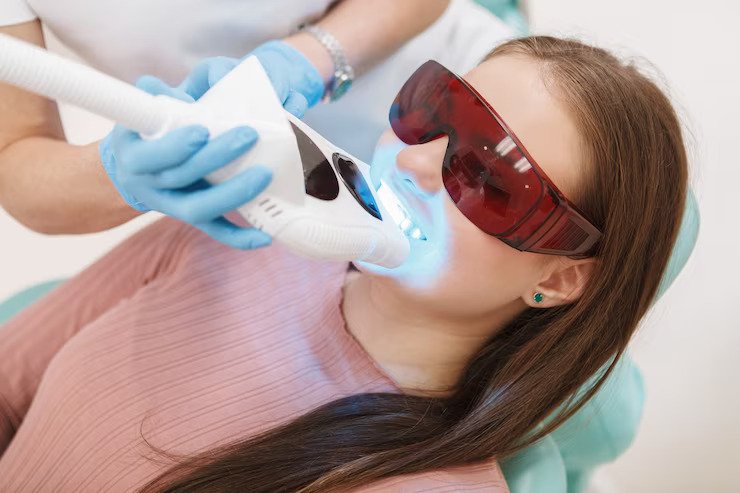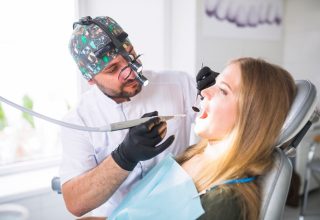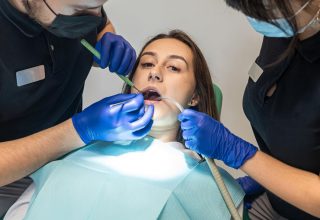Does Teeth Whitening With The Philips Zoom Lamp Cause Cracks?
Teeth whitening procedures have taken the cosmetic dentistry world by storm.
Among the most popular whitening methods, the Philips Zoom lamp stands out due to its efficient results and vast market reach. But as with any cosmetic treatment, there are always concerns. One such concern regarding the Philips Zoom lamp treatment is whether it causes cracks in the teeth.
Let’s delve deeper into this topic.
Reasons To Whiten Your Teeth
Questions may be raised from certain corners regarding the investment of high-end technology for teeth whitening. Why not be satisfied with whatever you have? Let us answer it.
Improving Your Appearances
The first and foremost advantage of whitening your teeth is the appearance. Your appearance is a reflection of the individual that you are. Different studies show that people with white teeth can socialize with people far better than others.
Confidence Is The Key
Simple psychology…majority of the people opine that they are using the teeth whitener because it enhances their confidence. Yes, you got it right; it is one of the possessions that keeps one ahead in this competitive world. Someone who sees your white teeth will undoubtedly have a higher impression on you.
Looking Younger
Teeth, like all the other parts of our body, give you a good impression of your age. A nice dress and a good physique are not sufficient to make you look younger but also have white teeth. Their acceptance in the professional arena is beyond question. Therefore, you must ensure that you look more youthful and jubilant to create a good first impression.
Different teeth whitening techniques are available that can help you meet your ends, but among the most modern ways is undoubtedly the Philip zoom lamp technique and their efficacy is climbing the new stairs of success and recognition.
Understanding The Philips Zoom Lamp Whitening Process

Before dissecting the concerns, it’s essential to understand how the procedure works. The Philips Zoom lamp uses a unique blue LED light-activated technology that accelerates the whitening process. When used in combination with the specifically formulated Zoom whitening gel, the procedure claims to remove deep-set stains and enhance the overall color of the teeth in a single session.
The Benefits And Advantages Of The Philips Zoom Lamp Whitening Process
Teeth whitening processes have their own benefits; therefore, experts consider it one of the most effective options. While discussing the tooth whitening processes, one of the most effective ones is the Philips Zoom lamp whitening process. It has its benefits. Let us take a glimpse at them.
Dental Consultation
Zoom teeth whitening processes’ first step is the dental consultation. Here, the patient’s condition is thoroughly reviewed. It has its own complexities and risks involved. This is the reason it is recommended for you to take the assistance of an expert. Go for the whitening only after a thorough discussion with your care users.
Post Procedure Responsibilities
After you go through the procedure, the experts will not leave at your will. You will have to maintain your teeth with a whitening kit. But simultaneously, you can get a consultation from the experts. It is undoubtedly one of the positives that you get with with the process.
More Effective Compared To The Other Whitening Options
Tea, coffee, chocolate drinks, and some other drinks or food often leave you with a stubborn stain on your teeth. However, with the help of the zoom lamp tech technology, the whitening strips will be removed completely using a substance. The larger concentration of the whitening agents helps create a brighter smile.
The patients sometimes take the help of some over-the-counter treatments. However, the harmful chemical agents that are found commonly in some of these treatment methods can create issues like harming the enamel. This enamel stripping could contribute to the sensitive teeth and gums. But you don’t face all these treatment methods.
Optional At-Home Application
One of the advantages of the Zoom-whitening process is the at-home application. You might be busy with your everyday schedule and need help to use the whitening trays back home. But you have flexible options with aftercare, and you do not have to worry much about it.
The Concern: Cracking In Teeth
The main worry for many is whether this accelerated whitening process, which involves heat and light, might damage the teeth’s structure, leading to micro-cracks or other structural issues.
What Research Says
Several studies have been conducted on the safety and efficacy of LED-light-activated teeth whitening procedures, including the Philips Zoom lamp.
- Tooth Enamel: Most studies conclude that such treatments, when done correctly, do not lead to any measurable damage to the tooth enamel. The enamel, being the hardest substance in the human body, can withstand the effects of the treatment.
- Micro-cracks: While our teeth naturally have micro-cracks due to the stresses they endure (like chewing), there hasn’t been any conclusive evidence linking the Philips Zoom lamp or other LED-light-activated procedures to an increase in these cracks.
- Tooth Sensitivity: While not directly related to cracks, some patients do report increased sensitivity after the procedure. However, this is a temporary effect and often subsides within days.
Preventive Measures
While the risks are minimal, if you’re considering a Philips Zoom whitening procedure, there are a few preventive steps you can take:
- Professional Assessment: Always get a thorough assessment by a licensed dentist before undergoing any cosmetic dentistry procedure. They can identify if you’re at risk for increased sensitivity or if your teeth have pre-existing vulnerabilities.
- Follow Post-Treatment Guidelines: Your dentist will provide specific instructions after the procedure. This might include avoiding certain foods and beverages for a few days or using a particular type of toothpaste to decrease sensitivity.
- Regular Check-ups: Maintain regular dental check-ups to ensure that your teeth remain in good health and any potential issues are identified early.
Conclusion
While concerns about treatments like the Philips Zoom lamp are valid, current research suggests that the procedure, when conducted correctly, doesn’t increase the risk of cracks in the teeth. Always consult with a dental professional to assess your individual needs and risks, and ensure you’re making informed decisions for your oral health.
Read Also:
- What Are Black Lines On Teeth? How To Get Rid Of It?
- A Clear Path To Straight Teeth: Exploring The Benefits Of Invisalign
- Glass Ionomer Fillings In Primary Teeth: An Essential Treatment Option



